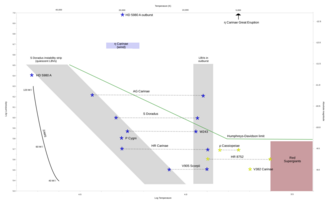 A visual band light curve for V905 Scorpii. The red points are from Sterken et al. (1997), [1] and the blue points are ASAS data. [2] | |
| Observation data Epoch J2000 Equinox J2000 | |
|---|---|
| Constellation | Scorpius |
| Right ascension | 17h 41m 59.025s [3] |
| Declination | −33° 30′ 13.71″ [3] |
| Apparent magnitude (V) | 6.66 [4] (6.3–6.9 [5] ) |
| Characteristics | |
| Spectral type | LBV |
| U−B color index | +0.30 [4] |
| B−V color index | +1.21 [4] |
| Variable type | LBV [5] |
| Astrometry | |
| Radial velocity (Rv) | −35 [6] km/s |
| Proper motion (μ) | RA: −1.75 [3] mas/yr Dec.: −1.49 [3] mas/yr |
| Parallax (π) | 0.54±0.54 mas [3] |
| Distance | 2,500 [7] pc |
| Absolute magnitude (MV) | −8.9 [8] |
| Details | |
| Mass | 13 [8] M☉ |
| Radius | 150–330 [5] R☉ |
| Luminosity | 290,000 [7] L☉ |
| Surface gravity (log g) | 0.55 [8] cgs |
| Temperature | 8,000–12,000 [5] K |
| Rotational velocity (v sin i) | 45 [5] km/s |
| Other designations | |
| V905 Sco, HD 160529, CD −33°12361, SAO 209151, HIP 86624 | |
| Database references | |
| SIMBAD | data |
HD 160529 (V905 Scorpii) is a luminous blue variable (LBV) star located in the constellation of Scorpius. With an apparent magnitude of around +6.8 it cannot be seen with the naked eye except under very favourable conditions, but it is easy to see with binoculars or amateur telescopes.
